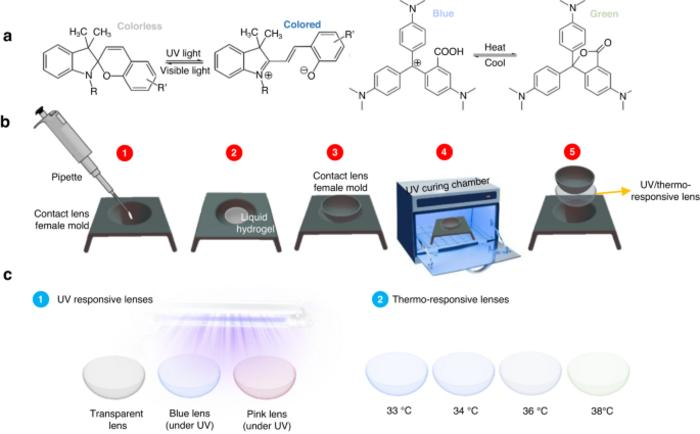Better treatment strategies are urgently needed, as evidenced by the rise in eye diseases around the world, which is mostly attributable to inadequate ophthalmic diagnosis and monitoring. Treating these disorders is now possible, thanks to groundbreaking advancements in therapeutic and diagnostic contact lens technology.

a Chemical structure of photochromic and thermochromic powders (LEFT) spiropyran structured material (colorless) switching to merocyanine (colored) and (RIGHT) Fluoran leuco dyes at protonated and deprotonated states. b Schematic of the lenses’ fabrication process. c Multifunctional contact lenses under different stimuli. Image Credit: A Salih, and H. Butt
A good example would be cataracts, which affect 94 million people and result in 10 million surgeries yearly and cloud the lens of the eye. Excessive exposure to ultraviolet (UV) radiation is a major contributing factor to the rise of cataracts and other eye conditions, such as age-related macular degeneration (AMD) and photokeratitis.
In response, a group of scientists at Khalifa University created cutting-edge UV-blocking contact lenses. Professor Haider Butt of the Mechanical Engineering Department and PhD student Ahmed Salih created their lenses with the help of intelligent materials like thermochromic and photochromic powders.
Depending on whether they are activated or inactivated, they have different optical characteristics. Their research was published in an article in Light Science & Applications.
While thermochromic particles react to temperature changes, photochromic granules change their structure in response to UV light. They can provide a more simple and cost-effective approach to treating and potentially preventing a variety of eye diseases when included in lenses.
About 45% of UV and 20% of blue light are efficiently blocked by these transition contact lenses under normal lighting conditions. The lenses darken instantly in response to UV radiation, absorbing some of the visible light. The particular photochromic material employed determines the pace and intensity of this change.
The use of various thermochromic and photochromic powders enables user-specific customization, allowing wearers to select lenses based on their personal requirements. Blue transition lenses, for example, react quickly, with 95% of their color change returning in less than five seconds after being exposed to UV radiation. Pink lenses, on the other hand, provide more intense coloration but take longer than 30 seconds to return to transparency.
UV light alone, however, does not determine eye health. Ocular surface temperature fluctuations, which typically occur between 31 and 37 °C, have been linked to conditions such as diabetic retinopathy, glaucoma, and dry eye. This has increased interest in employing cutting-edge contact lenses for real-time temperature monitoring.
The lenses developed by the Khalifa University team exhibit optical changes under physiological conditions and are multifunctional and temperature-sensitive. When exposed to UV rays from sunlight outside, they become darker and react to temperature changes.
The group’s multipurpose lenses exhibit remarkable colorimetric temperature responses in addition to their remarkable ability to filter UV and blue light. This creative usage of smart materials in contact lenses may be crucial to protecting vision as eye diseases become more common. They are positioned to function as both therapeutic and diagnostic tools.
Journal Reference
Salih, A. E., et al. (2023) Multifunctional transition and temperature-responsive contact lenses. Light Science & Applications. doi:10.1038/s41377-023-01304-1